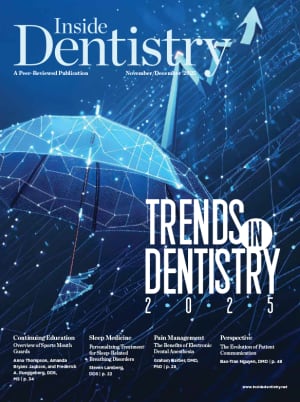Treating Fractured Teeth in the Esthetic Zone
Composite layering with putty stents achieves seamlessly blended restorations
When it comes to daily practice, dental professionals are managing patients who present with teeth that are decayed, discolored, worn, chipped, fractured, missing, and more. Oftentimes, the focus is on posterior teeth that are out of the "esthetic zone" and less esthetically demanding. However, patients do present who require restorations that are readily visible. Esthetically demanding cases require clinicians to be able to closely mimic the surrounding natural tooth structure, either with direct resin restorations or with indirect restorations. Before proceeding with either type of restoration, it is important to identify and understand the overall optical properties that the restoration will need in order to achieve the final result. This case report demonstrates how the use of modern composite resins in a layering protocol can enable clinicians to predictably achieve excellent optical properties that mimic the surrounding tooth structure when restoring fractured teeth.
Case Report
A 32-year-old male patient presented to the office with the chief complaint that he had tripped on a curb, fell, and fractured his front teeth. His medical history was reviewed and determined to be noncontributory. Other than the patient's overall concerns about his appearance, he noted that he was experiencing some sensitivity to cold but otherwise had no other symptoms. A limited exam was performed, and it was found that teeth Nos. 6 through 8 had been fractured in the fall. Fortunately for the patient, there was no pulpal exposure noted, and all of the teeth tested normal to pulpal tests.
After a discussion with the patient, it was decided that direct resin restorations were the treatment option of choice. Due to time constraints and the amount of missing tooth structure, pretreatment photographs (Figure 1 through Figure 6) and a digital scan (3Shape TRIOS® 5, 3Shape) were obtained at the initial visit. The digital scan was used to recreate the missing tooth structure, and then a model was fabricated on an in-office 3D printer (Asiga MAX, Asiga). Next, the 3D printed model was used to create two different putty stents-one that was trimmed to help recreate the palatal shelf and another that was trimmed to help recreate the final facial contours (Figure 7).
When the patient returned to the office to have the direct resin restorations placed, it was determined that anesthesia would not be necessary. Cotton rolls were placed, and preparation began with tooth No. 7. First, a 45° bevel was placed in the enamel, followed by an infinity or "starburst" bevel beyond that area to ensure seamless blending of the margin (Figure 8 through Figure 11). Next, polytetrafluoroethylene (PTFE) tape was used to isolate the adjacent teeth, and tooth No. 7 was etched with 35% phosphoric acid beyond the margin, rinsed, and dried thoroughly. After drying, a universal adhesive (Ecosite Bond, DMG America) was placed, air-thinned, and light cured for 30 seconds (VALO™ X, Ultradent). To recreate the palatal shelf, a universal nanohybrid composite (Ecosite Elements [shade Enamel Bleach], DMG America) was placed on the palatal aspect of tooth No. 7 first and then contoured into the putty stent (Figure 12). It was thoroughly light cured for 30 seconds, and the putty stent was removed. With the lingual shelf completed, the next layers of composite were placed using a combination of the pure shade A1 and the highlight shades Opaque A2 and Incisal to mimic the adjacent teeth. Each layer was thoroughly light cured for 30 seconds. A final layer of shade Enamel Bleach was placed to mimic the enamel layer, and it was also thoroughly light cured for 30 seconds. Once tooth No. 7 was restored, it was wrapped with PTFE tape, and the adjacent fractured teeth were treated in similar fashion (Figure 13).
The restorations were polished using a series of polishing discs (VersaFlex™, Brasseler) from course to fine, and then fine and superfine diamond burs (8872, Brasseler ) were used to create developmental lobes and surface texture. The final polish was accomplished using flexible composite polishing spirals (Diacomp™ Feather Lite™, Brasseler) followed by a felt-coated polishing buff (FlexiBuff®, Cosmedent) with polishing paste (Enamalize™, Cosmedent). The patient stated that he was ecstatic with the final result (Figure 14 through Figure 18).
Jeffrey Lineberry, DDS
Fellow
Academy of General Dentistry
Fellow
International Congress of Oral Implantologists
Accredited Member
American Academy of Cosmetic Dentistry
Chief Clinical Officer
Bela Family Dentistry
Mooresville, North Carolina
